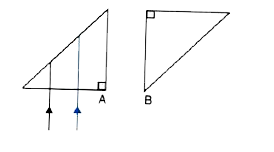With the help of the diagram, show the biasing of light emitting diode. Give its two advantages over conventional incandescent lamps.
Step-by-Step Text Solution:
Step 1: Understanding the Structure of a Light Emitting Diode (LED)
A Light Emitting Diode (LED) consists of a p-n junction formed by p-type and n-type semiconductors. The p-type semiconductor contains holes (positive charge carriers), while the n-type semiconductor contains electrons (negative charge carriers).
Step 2: Drawing the Diagram
1. Draw a horizontal line to represent the p-n junction.
2. Label the left side as the p-type region and the right side as the n-type region.
3. Indicate the depletion region in the middle where the two types of semiconductors meet.
Step 3: Forward Biasing the LED
- Connect the positive terminal of a power supply to the p-type region.
- Connect the negative terminal of the power supply to the n-type region.
- This configuration allows current to flow through the LED, as it is forward biased.
Step 4: Movement of Charge Carriers
- In the forward-biased condition, electrons from the n-type region move towards the p-type region, and holes from the p-type region move towards the n-type region.
- As electrons and holes recombine in the depletion region, energy is released in the form of light.
Step 5: Emission of Light
- The light emitted is typically in the visible spectrum, ranging from 400 to 700 nanometers, which is why we can see the light produced by the LED.
Step 6: Advantages of LEDs over Conventional Incandescent Lamps
1. Low Operational Voltage and Power Consumption: LEDs operate at a lower voltage and consume significantly less power compared to incandescent lamps.
2. Fast On-Off Switching Capability: LEDs can turn on and off very quickly without any warm-up time, making them more efficient for applications requiring rapid switching.
A Light Emitting Diode (LED) consists of a p-n junction formed by p-type and n-type semiconductors. The p-type semiconductor contains holes (positive charge carriers), while the n-type semiconductor contains electrons (negative charge carriers).
1. Draw a horizontal line to represent the p-n junction.
2. Label the left side as the p-type region and the right side as the n-type region.
3. Indicate the depletion region in the middle where the two types of semiconductors meet.
- Connect the positive terminal of a power supply to the p-type region.
- Connect the negative terminal of the power supply to the n-type region.
- This configuration allows current to flow through the LED, as it is forward biased.
- In the forward-biased condition, electrons from the n-type region move towards the p-type region, and holes from the p-type region move towards the n-type region.
- As electrons and holes recombine in the depletion region, energy is released in the form of light.
- The light emitted is typically in the visible spectrum, ranging from 400 to 700 nanometers, which is why we can see the light produced by the LED.
1. Low Operational Voltage and Power Consumption: LEDs operate at a lower voltage and consume significantly less power compared to incandescent lamps.
2. Fast On-Off Switching Capability: LEDs can turn on and off very quickly without any warm-up time, making them more efficient for applications requiring rapid switching.
Similar Questions
Give any one advantage of LEDs over conventional incandescent low power lamps
View SolutionExplain briefly with the help of necessary diagram, the forward and the reverse biasing of p-n junction diode. Also draw their characteristic curves in the two cases.
View SolutionOxygen atom in water has two 'lone pair of electrons'. Explain the meaning of the term in italics. With the help of an electron dot diagram show the formation of hydronium ion and ammonium ion from a water molecule and an ammonia molecule respectively.
View Solution(a) Explain, giving reasons, the basic difference in converting galvanometer into (i) a voltmeter and (ii) an ammeter.
(b) Two long straight parallel conductors carrying steady currents I1andI2 are separated by a distance 'd'. Explain briefly, with the help of a suitable diagram, how the magnetic field due to one conductor acts on the other. Hence deduce the expression for the force acting between the two conductors. Mention the nature of this force.View Solution(a) How does an unpolarized light incident on polaroid get polarized ?
Describe briefly, with the help of necessary diagram, the polarization of light by reflection from a transparent medium. (b) Two polaroids 'A' and 'B' are kept in crossed position. How should a third polaroid 'C' be placed between them so that the inlensity of polarized light transmitted by polaroid B reduces to 1/8th of the intensity of unpolarized incident on A?View SolutionGive two advantages that non-conventional energy sources have over conventional energy sources.
View Solution(a) A mobile phone lies along the principal axis of a concave mirror. Show, with the help of a suitable diagram, the formation of its image. Explain why magnification is not uniform.
(b) Suppose the lower half of the concave mirror's reflecting surface is covered with an opaque material. What effect this will have on the image of the object? Explain.View Solution(a) Explain with the help of suitable diagram , the two processes which occur during the formations of a p -n junction diode . Hence , define the terms :
(i) depletion region and (ii) potential barrier :
(b) Draw a circuit diagram of a p - n junction diode under forward bias and explain its working .View SolutionShow with the help of a diagram how a total reflecting prism can be used to turn a ray of light through 90∘. Name one instrument in which such a prism is used.
View Solution(a) Figure shows two isosceles right angled prisms A and B and the light rays incident on the prism A. complete the diagram to show the rays emerging out of the prism B.
(b) State the principle used for completing the ray diagram in part (a) above.
 View Solution
View Solution

